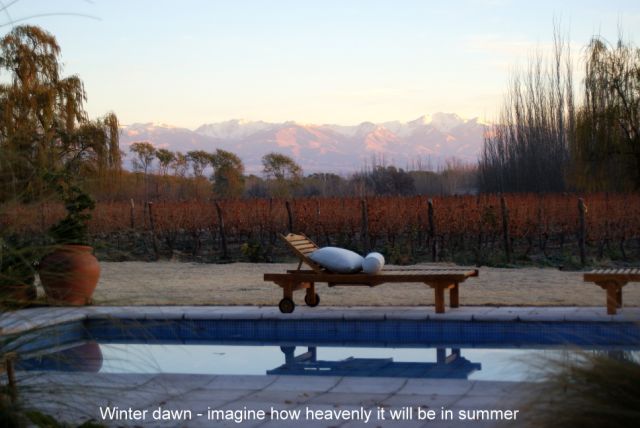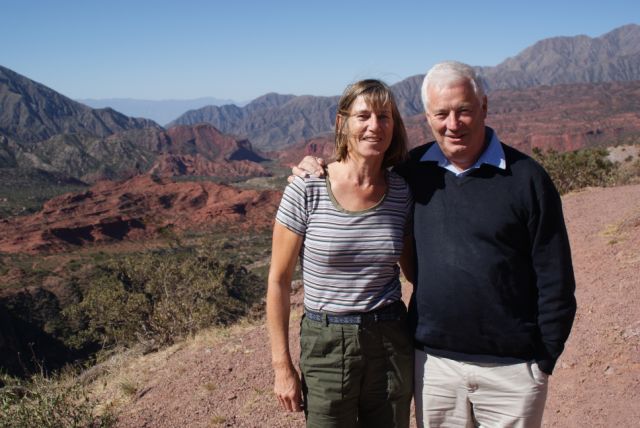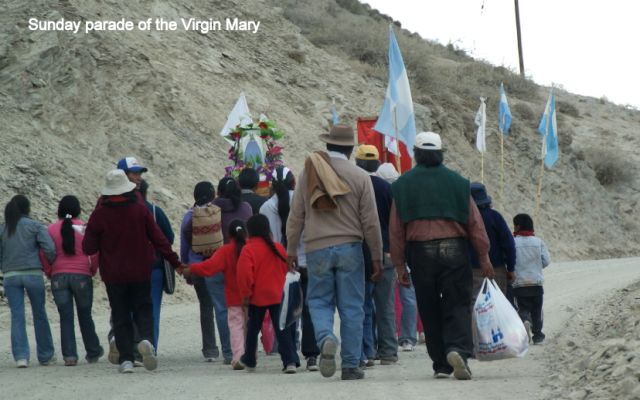Argentina 1

Argentina Our South American journey continues by spending a month in Argentina. As it is the eighth biggest country in the world, we had to decide which part of the country we should explore. We enlisted the help of ‘Heart of Argentina Travel’, which is run by a Dutch/Argentinean couple who have a passion for this county and who seem dedicated to introducing customers to its highlights. John and I love the freedom and independence of driving. The first part of the trip was a 3000 mile journey exploring the north-west of Argentina. Heading north from Mendoza, we followed the line of the Andes – sometimes close to its spine, sometimes driving through some of the many sierras that define the vast valleys. Our route took us through the Valle de Luna with its wild llamas and weird rock formations; Tafi del Valle, which reminded us of Wales; Valley Calchaquies, its narrow road winding through jagged rocks and the to Cafayate, a prosperous wine-growing town. We saw the huge cactuses of the National Park Los Cardones and enjoyed meandering through the mountains to Salta. Tilcara, close to the Bolivian border was our most northern stop and then back south to Tucuman and Cordoba – Argentina’s second city, before finally returning the car to Mendoza. Our plans for the second stage of our trip were changed by a volcano erupting in Chile, spewing ash over the belt of Argentina that includes Buenos Aires, which is the hub to everywhere and all flights seem to generate from it. Having spent hours at the airport, with flights booked and rebooked we resorted to bus travel – a 13 hour trip to the capital and then an 18 hour trip from Iguazu in the north-east. Still, the bus system is fantastic, frequent and on time. Some buses have lie-flat seats and meals are served, both of which ease the pain of such long journeys. We have stayed in a wide variety of places: a finca, an estancia, a boutique hotel, vineyard, town house and a small room in somebody’s house. As well as the peculiarity that no residence seemed to have a plug for the sink or bath (it was the same in Chile), it was odd that we were nearly always the only people visiting. (It is out of season, but even so.) Until the last week of a stay in South America, we have only come across one other Brit and very few people have spoken English. Often, when we arrived at a place, we were asked whether we were married; one place even wanted to know how long we had been married. It may be odd to talk about roads, but they deserve a mention. I don’t know, but it looks as though there has been a lot of investment in upgrading roads in the last ten years, with a lot of construction work still going on. Road-making is made harder by the water that pours down from the Andes at certain times of the year, changing river courses and eroding the road base. Distances between places are huge. There are vast spaces of nothingness except scenery on a grand scale. You can be the only vehicle on the road for a 15 or 20 mile stretch. The road slices through the valley; straight; mile after mile; smooth with wide verges. And then the arterial route just comes to an abrupt stop, falling off a ramp to a dirt track, slowing you down to third or even second gear to negotiate the potholes and forcing you to pick your way with caution. One such stretch was more than 30 miles long. Sometimes the road is so narrow it is difficult for two vehicles to pass, whilst when it widens it encourages speed and an oncoming truck covers you in dust. Fuel stations can be very few and far between. We have seen delayed fuel deliveries and power cuts causing very long queues at fuel stations, with drivers really concerned that they would make their destination. But let’s get back to what is amazing in Argentina: the scenery. It’s vast, staggering and dramatic. The enormity of it all is breathtaking. You are an insignificant speck in an immense and imposing landscape, yet have beauty and majesty stretch out in all directions as far as the eye can see. With very little rainfall and scant vegetation, the rugged outlines are made more dramatic by the multi-coloured rocks which fold in layer upon layer to form a mountain range, ridge behind ridge, each illuminated to give a different hue as they recede in to the distance. Near Tilcara there is such an array of minerals that the view creates a picture coloured with the vivid imagination of a child. Yet the rock is soft and the water from the Andes cuts through it with ease, creating wide river beds strewn with boulders. The power of the water in full flood must be awesome. In the Calchaqui Valley rocks have been thrust from horizontal to vertical and the road cuts through between gaps in the strata. Argentina’s wealth is in its land production. The country has gold, silver and copper, yet it chooses not to exploit it to anything like the extent it could. (For instance, before WW1 there was an amazing British/German engineering feat to extract gold from the Andes, but it was not continued by the Argentineans.) We saw bannered messages of protest against mineral extraction. On the other hand, the vast dry valleys are spread with gold in the form of vines, the channelled mountain water giving life to over 200,000 hectares of vines, a crop which generates a vast industry and supports grand estates. The scale and monoculture of vine-growing in the Mendoza area is truly staggering. Further east and with more rainfall there is mile upon mile of sugar cane and maize and then, of course, there is the world-renowned beef of the Pampas. Further north, people work small-holdings with fruit, peppers and walnut crops. In areas without water it is only the cacti that grow. Cordoba, Mendoza and Tucuman all reflect the wealth its region has to offer, with opulent churches, imposing bank and official buildings of the late 1800s and elegant parks. As we headed north so prosperity lessened and the remoteness increased. The Jesuit influence still shows in the churches and street layout of some of the towns. Cachi is a wonderful example of this, with wide cobbled streets, channelled water, uniform, houses with tall, elegant doors and wrought ironwork at the windows. Many of the small villages however consist of adobe houses and dirt roads. Yet there is strength in the community and a comfortable acceptance of what we perceived as basic housing. Wherever we went, however remote, there would be a school. Even in a half-horse town of 12 houses. (Talking of horses, it is a very common form of transport, particularly where the roads are just dirt tracks and the more mountainous areas.) We wondered how people make a living. Agriculture is hugely important of course, but there seemed to be a lot of people with half-jobs: they were there for the sake of being employed. For example, one small town not only had a tourist office, but it was open from 7am to 10 pm. It seems that each town is only allowed to give information of the immediate area, so there were only two leaflets that could be given out, yet when I visited it there were three people behind the counter. Perhaps something has got lost in translation. This is a spiritual nation. Village groups parade the Virgin Mary. Whatever day, whatever time we visited a church, there would be people praying or sat contemplating. As people past a church many would cross themselves. Even in the poor north, the churches had gold, elaborate effigies and some fine art work. Yet it seemed an anomaly that two strong cults co-exist with the church. One is the following of Difunta Correa. Technically she is not a saint, but a ‘soul’, a dead person who performs miracles and intercedes for people. There are a huge number of shrines where vast numbers of plastic bottles are stacked up to her along the roadside (Correa apparently died of thirst).here is one major shrine which is visited all year round, and we are told that at Easter, May 1st and Christmas up to 200,000 pilgrims descend on it. There are also lots of shrines to Gauchito Gill who seems to be a sort of Robin Hood/Gaucho character. Another strange anomaly is how nearly all Argentineans are skinny. They consume more beef (about 70 kilos per year) per capita than any other country. The parrilla (steak house) offers prime steak, ribs, offal, intestines and more, and whatever you choose there will be a lot of it. A hugely popular thing is to get together for an asado, a barbeque, when vast amounts of meat are consumed, along with some good wine. The Argentineans are also one of the world’s highest per capita consumers of sugar, not only in the form of sweets, cakes, dulce de leche, and ice-cream, but hidden in pre-sweetened coffee and foods that I had never considered adding sugar to. I think the answer to their slim figures and clear complexions is down to drinking Mate. More than a simple drink, mate (may-tee) is an elaborate ritual shared among family, friends and co-workers. In many ways, sharing is the whole point. Yerba mate is the dried chopped leaf of a plant similar to holly. The average consumption of this leaf is 5 kg per year, more than four times the average intake of coffee. To make an infusion hot water is poured on to the leaves which are packed in to anything from a gourd to a decorative silver cup. It is drunk through a silver straw, more water added, and passed on. People drank it on the bus and passed it to the driver; military guards drank it on duty; office workers have it at their desks and someone’s mate cup will be placed on a shop counter. Thermoses are filled at shops, garages and water dispensers in order that it can be consumed at any time of the day. (John’s description of it is probably not printable here!) Also odd to us was the sheer number of police. We certainly never felt that we were in a risky situation, nor did we see any sign of crime: perhaps it’s exactly because of the sheer number of police. There would be a police station at even the tiniest community way up in the mountains. At each county boundary and on the outskirts of many towns there were police check points, although their main concern seemed to be stopping the spread of fruit flies. (We had to give up our oranges.) The police seemed to have no concern about the traffic. It must be the law to have a bike helmet, but it would not be considered de rigueur to use it. A biker will dangle it from his arm or have it perched on the back of his head with the visor pointing to the sky. We have seen a baby propped between a couple as they ride a moped, the woman texting with one hand and holding shopping in another. One motorcyclist was very deftly using his phone and smoking whilst driving round the central plaza. As for driving a car in town, it is definitely a game of chicken. You need bravado and to be able to weave through gaps with just a couple of inches to spare. The disparity here between men and women amused me: I had forgotten how egalitarian the UK is. We are heavily burdened with enough kit for six months travel and for different seasons and activities. John has a bag with wheels and I have a huge back-pack. Whenever we got to our accommodation I was completely ignored, all the head-nodding and pleasantries being showered on John. There would then be a huge fuss made of taking John’s bag to our room, while I had to yank my heavy load on my back and follow on behind. When I have asked for directions, the answer has been to John. But the men do pay attention really, much evidenced by the kissing and canoodling that goes on the benches in the plaza – a leafy and elegant square with trees, statues and fountains that seemed to be the essence of the town centre. So what have we been doing apart from being totally wowed by the scenery? We’ve been eating a lot of wonderful steak and drinking lots of good wine. We have been introduced to the pre-Columbian culture through museums and visiting the site of Quilmes, a site dating from 1000 AD, which housed up to 5000 Diaguita people. We didn’t do as much hiking as we would have liked, although it was very enjoyable to go for a walk with a tame llama. It was a highlight to spend a day with a gaucho and his partner, riding up through the woods and out on to a ridge. Whilst slabs of beef were being cooked over the open fire, we watched the condors use the thermals in the heat of the day and galloping for part of the way home has definitely given me a desire to do more. An absolutely amazing sight is the waterfalls at Iguazu, but more of those in the next blog…. |


















